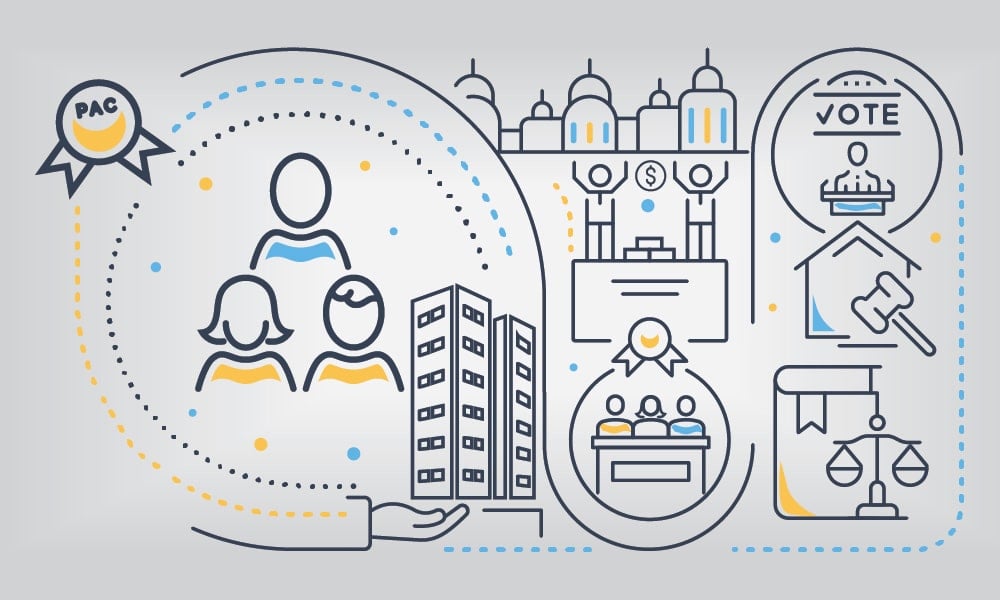Some PACs are More Super than Others
There is a cartoon by the late Charles Barsotti that a former colleague gave me several years ago that I still keep at my desk. It reads, “Some PACs, senator, are more super than others.” When reviewing the final summary reports of political spending in the 2018 election cycle, that’s never felt more true. Super PACs, political nonprofits and independent expenditure groups, so called “outside money,” spent record amounts in the last election cycle. Even amid calls for stricter campaign finance regulation, including the recently-introduced H.R. 1, the chances of curbing super PAC spending as we head into the 2020 presidential election is unlikely.
As I mentioned in my last column, much of the angst directed at traditional, corporate PACs is really misdirected frustration with a post-Citizens United world ridden with super PACs and other nonprofits able to spend millions in unlimited contributions in a single congressional race. Following how PACs operate is tricky enough for the average American that doesn’t live and breathe politics (or work in public affairs), so it’s understandable why there’s confusion between the two. Let’s break it down:
What are super PACs?
In Citizens United v. FEC, the Supreme Court found that prohibiting certain types of political speech by corporations, unions and other groups violated the First Amendment. The decision set a precedent that ushered in the creation of super PACs and other political nonprofits, which under Citizens United and subsequent rulings, can:
- Raise unlimited amounts of money from virtually anyone – corporations, associations, unions and individuals
- Spend unlimited amounts of money for political advertising, such as radio, TV and print ads, that are not coordinated with candidates or their campaigns, but can use words expressly advocating for the election or defeat of a candidate or issue
- Because it is prohibited for coordination to take place between a super PAC or independent expenditure committee and the federal candidate it is supporting, candidates have little control over outside money spent for or against their campaign
Without any contribution limits in place for outside spending groups, their influence and size has increased in each election cycle since the 2010 decision.
What’s this I hear about dark money?
Super PACs are required to register with the Federal Election Commission (FEC) and disclose their donors as well as expenditures. However, some political nonprofits are not subject to these same disclosure requirements, so-called “dark money” groups. These groups are also able to contribute directly to other super PACs providing a legal channel for a super PAC to accept unlimited amounts of dark money while reporting only the nonprofit as the donor instead of the real sources. The Center for Responsive Politics (CRP) found that super PACs and other outside spending groups accepted an estimated $176 million from undisclosed, dark money groups in the 2018 elections. Compare that with traditional PACs who must disclose every receipt over $200 and every expenditure, which is limited to just $5,000, per candidate or committee, per election.
What hasn’t Citizens United changed?
The ruling doesn’t change how traditional PACs operate, are regulated or the important role they play in the political process. Corporations and associations are still prohibited from directly supporting a candidate for federal office with contributions from their general treasury. This means PACs are still the only way corporate and association employees can combine funds to directly support candidates who have like-minded public policy priorities. The Citizens United decision does allow corporations to use general treasury funds to engage in independent expenditures of their own or support super PACs and nonprofit groups doing so, but again did not change the law that prohibits them from using corporate monies to contribute directly to a candidate for federal office. The Public Affairs Council’sPAC benchmarking data demonstrates that although corporations can now directly contribute to super PACs, the overwhelming majority have chosen not to. Furthermore, traditional PAC spending in elections has experienced only modest growth in the past decade. In fact, CRP reports that connected PACs contributed $497 million in the 2018 election cycle, compared to $416 million in the 2008 cycle, further demonstrating that blaming corporate PACs for the explosion of super PAC spending and influence in elections is misinformed.
All this is to say, the current anti-PAC sentiment among many congressional (and now presidential) candidates is largely misguided. While super PACs have reshaped the campaign finance landscape, in doing so, they have also reinforced the importance of traditional, connected PACs as the only way to directly fund a candidate in a highly regulated and transparent way while simultaneously bringing millions of small donors into the political process each year. Overall, it’s a very small percentage of Americans that exercise their First Amendment rights to contribute to political committees or candidates during the course of our elections. CRP reports that less than one percent (0.46 percent to be exact) of the U.S. population donate over $200 in political contributions. However, for those who do, contributing modestly to a connected corporate or association PAC is how many choose to participate.
In short, traditional PACs have been relying upon small-dollar donors for decades, long before the campaigns of Barack Obama, Bernie Sanders or Beto O’Rourke made it cool.

More News & Resources
Questions

Kristin Brackemyre
Vice President, Member Success & Practice
202-787-5969 | [email protected]
Whether you’re building cutting-edge campaigns, engaging communities on social, mobilizing advocates, or exploring the power of new AI tools, THIS is where the future of advocacy comes alive.


